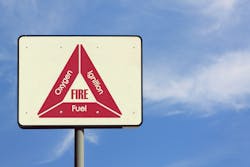HAZOPs: They’re only as good as the people involved.
A poorly designed dust-collection system led to the severe burning of seven workers at a U.S. Ink plant in New Jersey in 2012. It’s a situation I’ve seen several times during my career: low “pickup” velocity, low duct velocity and a poor understanding of the dust being collected prompted an accident. The New Jersey installation also suffered from poor commissioning practice — the engineer never fully tested it. It exemplifies remediation gone bad.
Here’s another example you won’t find on the website of the U.S. Chemical Safety and Hazard Investigation Board. Astaxanthin caught fire in a dryer at a bioproducts manufacturer. A half-dozen resistance temperature detectors (RTDs) were strategically located in the duct following at least two previous fires but no effort was made to fix the duct work, which likely caused the dust accumulation. The site added more RTDs after I left but never corrected the duct work.
To address dust fire hazards, you must reduce two risks: 1) static ignition; and 2) fire risk from heating.
Typical countermeasures are:
- dust collection;
- housekeeping;
- inspections;
- hazard and operability studies (HAZOPs); and
- layout changes.
Grounding and bonding are critical to breaking the fire triangle: fuel-oxidizer-ignition source. However, such efforts alone won’t save you: dusts often provide their own fuel and oxidizer. Inspections and constant vigilance are the answer — as is good design. Consider an outside consultant to train and retrain your people; training gaps are a constant source of problems. Inspections should include top-down and bottom-up. Have a third-party review design changes and do a post-mortem on construction and commissioning work. Integrate all consultant work between corporate and plant.
Understanding heating risk involves both combustion chemistry and environment. Remember, a combustible liquid’s flash point can be much lower than reported, by 100°F perhaps, depending on the situation. Dust hazard tests are even less precise.
Some dusts, like Astaxanthin, can self-heat, resulting in an explosion. Others are great insulators and can cause a fire as insulation burns off a motor.
Now, let’s consider some solutions.
Dust collectors are your last line of defense; good design is your first. You can justify collectors based on recovery of valuable product. However, they might not work right if you don’t consider these factors:
- poor pickup;
- tramp air leaks into ducts;
- an inaccurate pressure drop estimate;
- high pressure drop because of wetted bags or cartridges; and
- holes in filter media.
These are the main causes of failure. Items 1, 3, and 4 reflect poor design; items 1, 2, 4 and 5 also can stem from poor maintenance.
Unless you make housekeeping as easy as possible, your people will cut corners. Edward Deming created the red bead experiment to show executives how impossible they made their workers’ jobs; don’t do that! Streamline the process floor and equipment to reduce hands-on work as much as possible. Erase the clutter. Did you ever see the 1981 film “Das Boot?” Does your plant floor look like the inside of a U-boat?
Inspections won’t work if everyone knows they’re coming. Keep an element of surprise. Encourage workers to take the initiative to identify issues during interviews. One reason dust is ignored is because management won’t spend money to fix problems; so, incentivize improvements and publicize changes and failures as they occur.
HAZOPs should reveal problems with your operation but often fall short of this lofty goal. If they aren’t deep enough, simply rely on checklists, and allow teams to sleepwalk through them, HAZOPs will be nearly useless.
One reason people often seem disinterested during the process is because they believe a site won’t spend the money to fix problems. I once sat in on a HAZOP on the same day the plant manager gave us a vigorous lecture on not spending money. I can’t tell what happened the rest of the week as I think I was asleep.
Let me offer another important tip on HAZOPs: They’re only as good as the people involved. Too often, turnover, takeovers, and excluding line workers in the belief they don’t understand the process undermine the value of HAZOPs.
Sometimes, you just have to start over. Equipment parts aren’t available. Breakdowns can’t be made up by a second shift. Dust is everywhere. Weigh the cost of production disruptions and improve the layout.
About the Author

Dirk Willard
Contributing Editor
DIRK WILLARD is a former ASBPE award-winning columnist for Chemical Processing's Field Notes column. During his 10+ years as a contributing editor for CP, he wrote hundreds of valuable and insightful pieces on design and operational issues. He retired in 2023.
